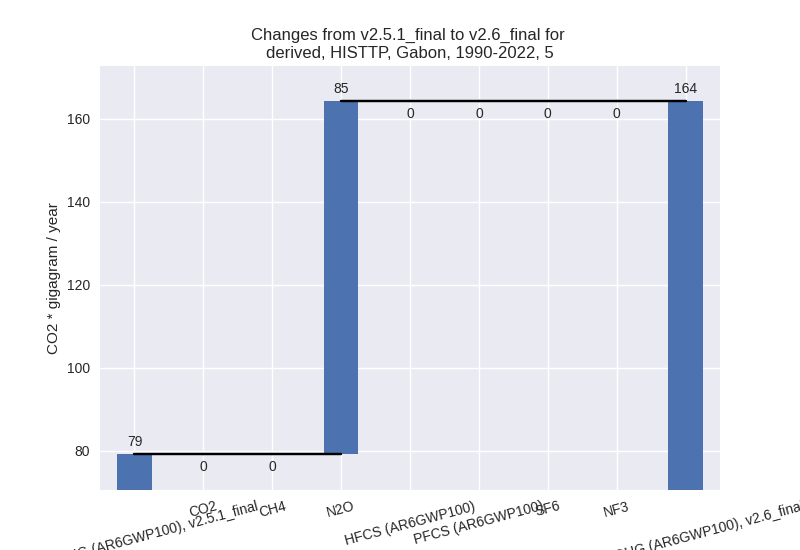Changes in PRIMAP-hist v2.6_final compared to v2.5.1_final for Gabon
2024-09-24
Johannes Gütschow
Change analysis for Gabon for PRIMAP-hist v2.6_final compared to v2.5.1_final
Overview over emissions by sector and gas
The following figures show the aggregate national total emissions excluding LULUCF AR6GWP100 for the country reported priority scenario. The dotted linesshow the v2.5.1_final data.
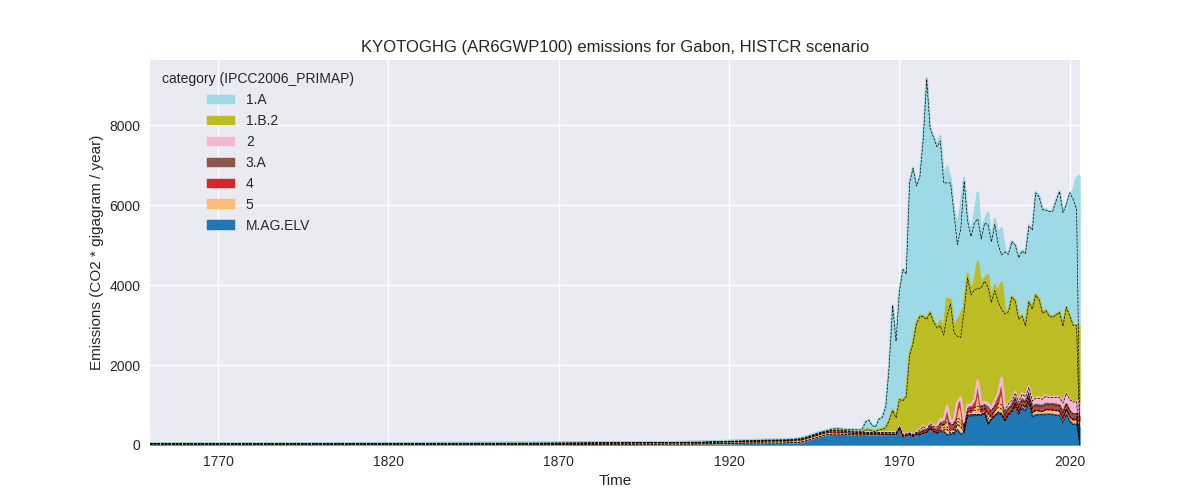
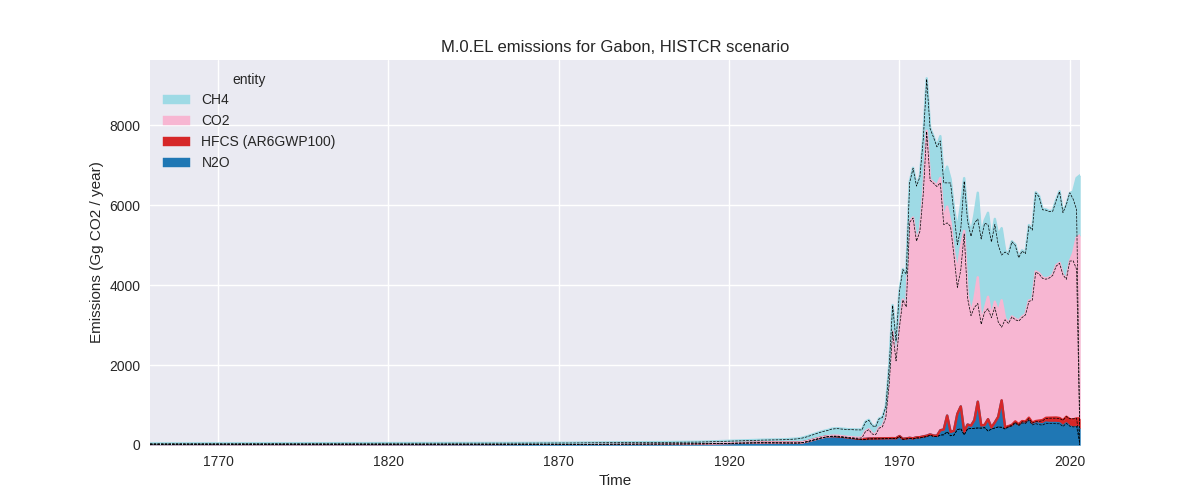
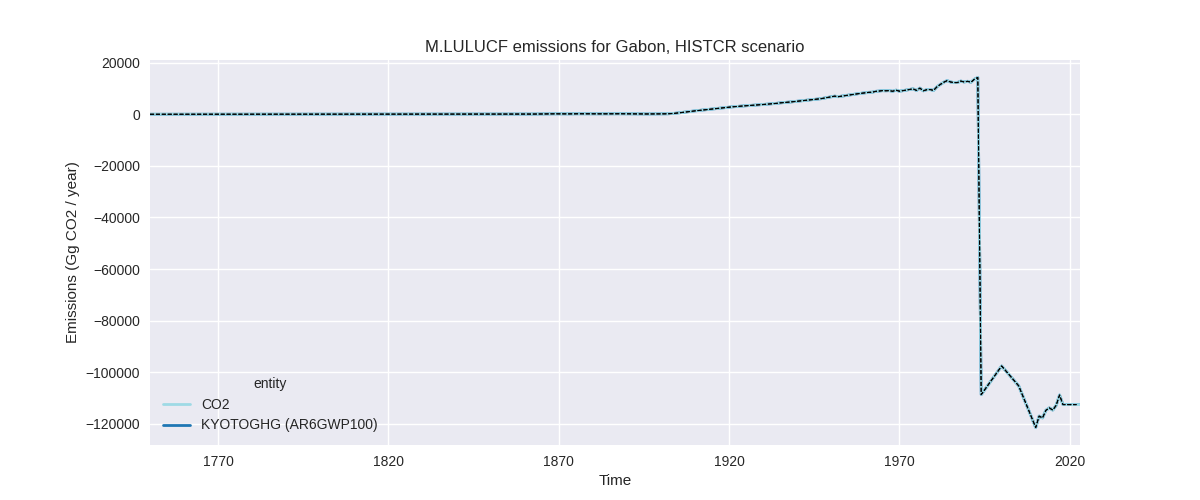
The following figures show the aggregate national total emissions excluding LULUCF AR6GWP100 for the third party priority scenario. The dotted linesshow the v2.5.1_final data.
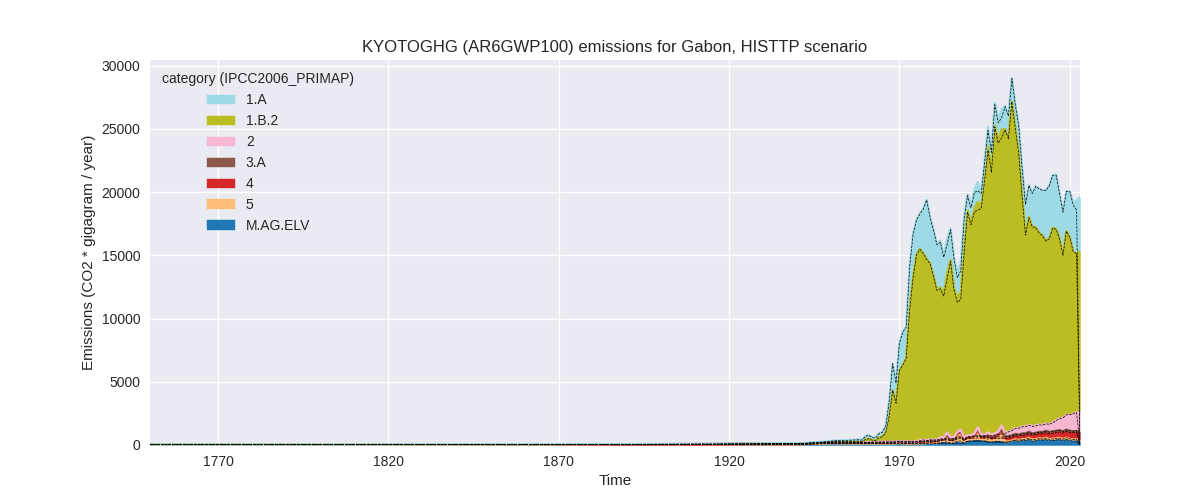
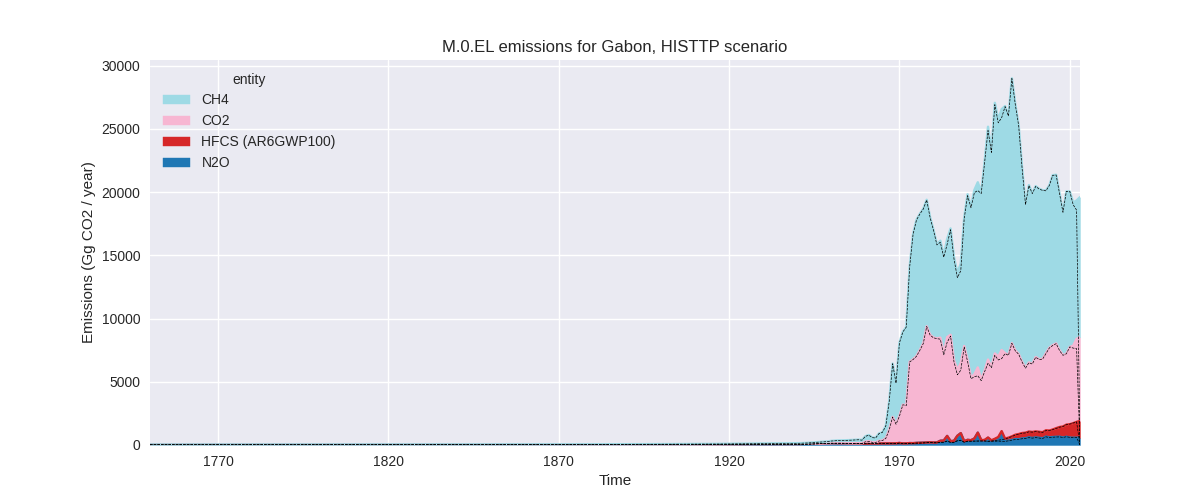
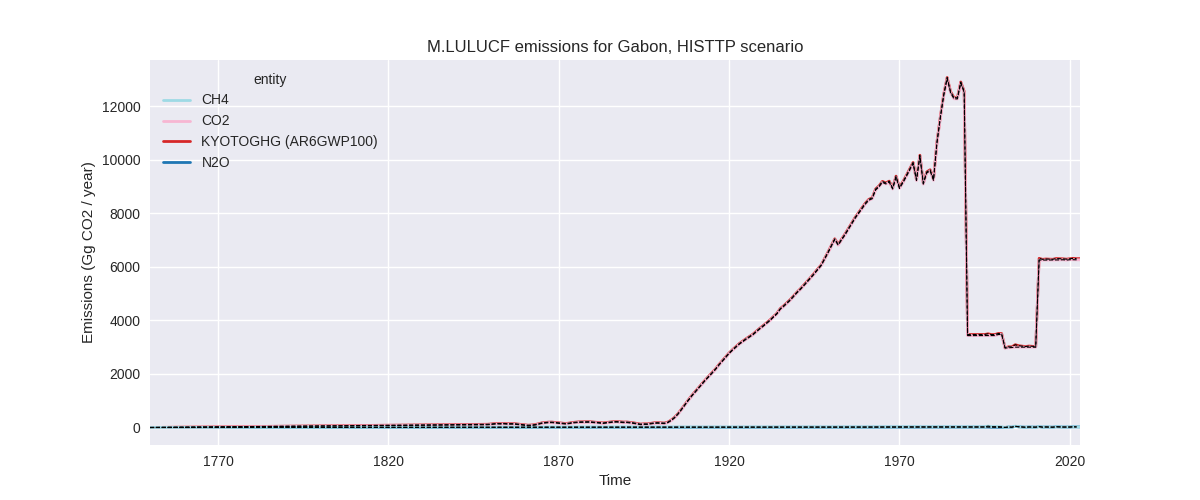
Overview over changes
In the country reported priority scenario we have the following changes for aggregate Kyoto GHG and national total emissions excluding LULUCF (M.0.EL):
- Emissions in 2022 have changed by 13.4%% (788.40 Gg CO2 / year)
- Emissions in 1990-2022 have changed by 2.1%% (117.24 Gg CO2 / year)
In the third party priority scenario we have the following changes for aggregate Kyoto GHG and national total emissions excluding LULUCF (M.0.EL):
- Emissions in 2022 have changed by 4.1%% (759.37 Gg CO2 / year)
- Emissions in 1990-2022 have changed by 0.5%% (115.30 Gg CO2 / year)
Most important changes per scenario and time frame
In the country reported priority scenario the following sector-gas combinations have the highest absolute impact on national total KyotoGHG (AR6GWP100) emissions in 2022 (top 5):
- 1: 1.A, CO2 with 784.72 Gg CO2 / year (27.3%)
- 2: 2, HFCS (AR6GWP100) with 17.16 Gg CO2 / year (8.5%)
- 3: 5, N2O with -16.70 Gg CO2 / year (-11.5%)
- 4: M.AG.ELV, CO2 with 3.28 Gg CO2 / year (247.5%)
- 5: 4, CO2 with -0.03 Gg CO2 / year (-1.2%)
In the country reported priority scenario the following sector-gas combinations have the highest absolute impact on national total KyotoGHG (AR6GWP100) emissions in 1990-2022 (top 5):
- 1: 5, N2O with 84.98 Gg CO2 / year (107.3%)
- 2: 1.A, CO2 with 30.01 Gg CO2 / year (1.5%)
- 3: M.AG.ELV, CO2 with 1.74 Gg CO2 / year (182.7%)
- 4: 2, HFCS (AR6GWP100) with 0.52 Gg CO2 / year (0.8%)
- 5: 4, CO2 with -0.00 Gg CO2 / year (-0.3%)
In the third party priority scenario the following sector-gas combinations have the highest absolute impact on national total KyotoGHG (AR6GWP100) emissions in 2022 (top 5):
- 1: 1.A, CO2 with 764.76 Gg CO2 / year (27.3%)
- 2: 2, HFCS (AR6GWP100) with 17.98 Gg CO2 / year (1.5%)
- 3: 5, N2O with -16.70 Gg CO2 / year (-11.5%)
- 4: 4, CH4 with -8.15 Gg CO2 / year (-1.6%)
- 5: M.AG.ELV, CO2 with 3.28 Gg CO2 / year (247.5%)
In the third party priority scenario the following sector-gas combinations have the highest absolute impact on national total KyotoGHG (AR6GWP100) emissions in 1990-2022 (top 5):
- 1: 5, N2O with 84.98 Gg CO2 / year (107.3%)
- 2: 1.A, CO2 with 29.24 Gg CO2 / year (1.4%)
- 3: M.AG.ELV, CO2 with 1.74 Gg CO2 / year (182.7%)
- 4: 4, CH4 with -0.99 Gg CO2 / year (-0.3%)
- 5: 2, HFCS (AR6GWP100) with 0.54 Gg CO2 / year (0.1%)
Notes on data changes
Here we list notes explaining important emissions changes for the country. ’' means that the following text only applies to the TP time series, while means that it only applies to the CR scenario. Otherwise the note applies to both scenarios.
- We have no new country reported data.
- Liming CO2 from NIR were missing in PRIMAP-hist v2.5.1 and are now included leading to an increase in agricultural CO2 with a small effect on total emissions.
- For 2022 energy CO2 is over 27% higher due to adjusted EI data.
- Changes in sectors 4 and 5 are due to the removal of FAOSTAT data.
- Changes in the CR and TP scenarios are very similar.
Changes by sector and gas
For each scenario and time frame the changes are displayed for all individual sectors and all individual gases. In the sector plot we use aggregate Kyoto GHGs in AR6GWP100. In the gas plot we usenational total emissions without LULUCF. ## country reported scenario
2022
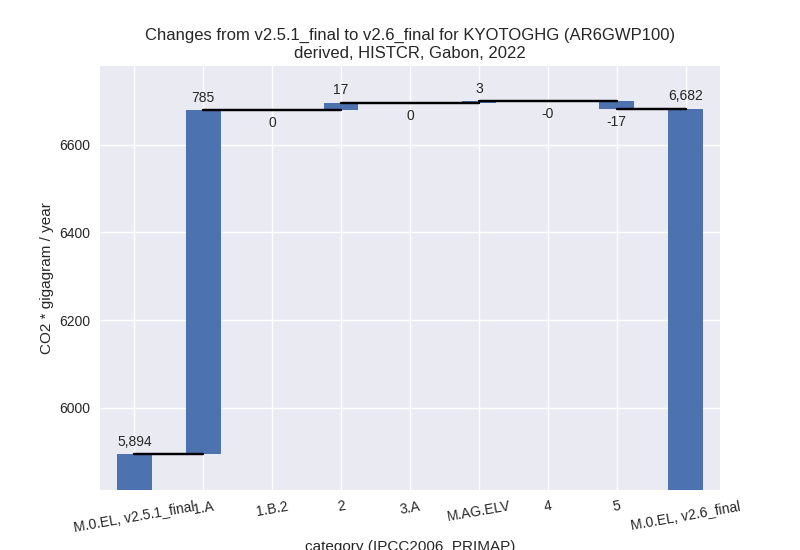
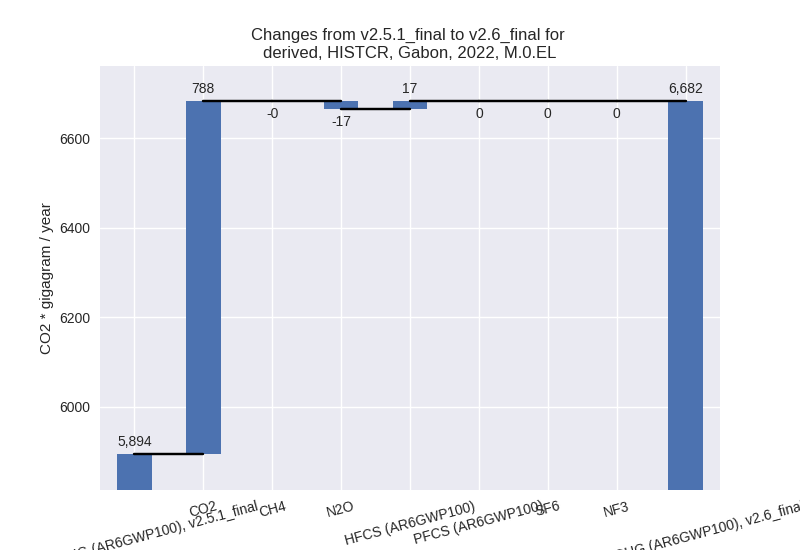
1990-2022
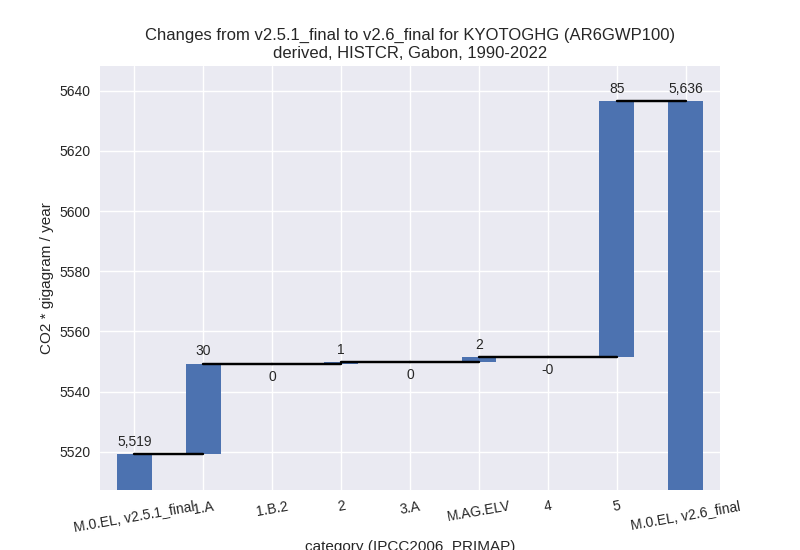
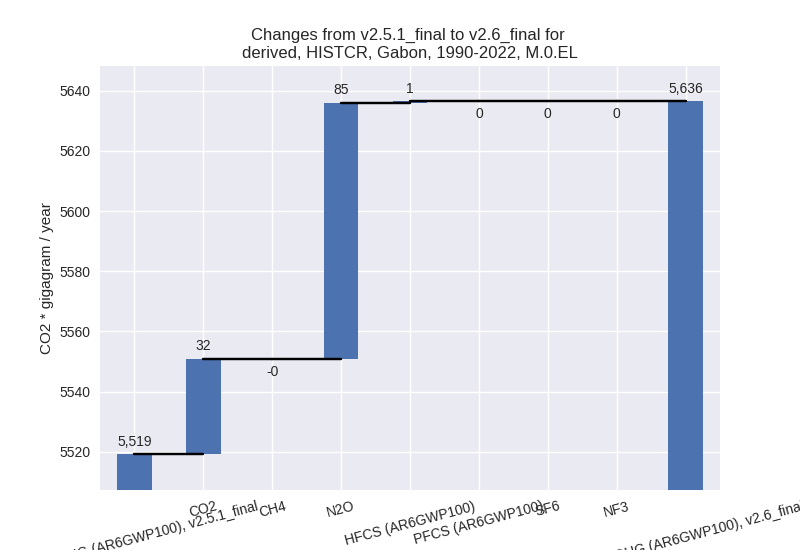
third party scenario
2022
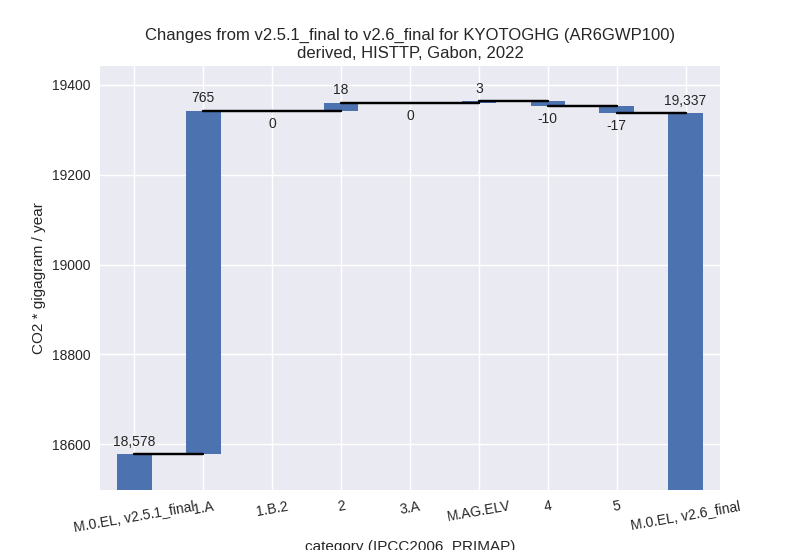

1990-2022
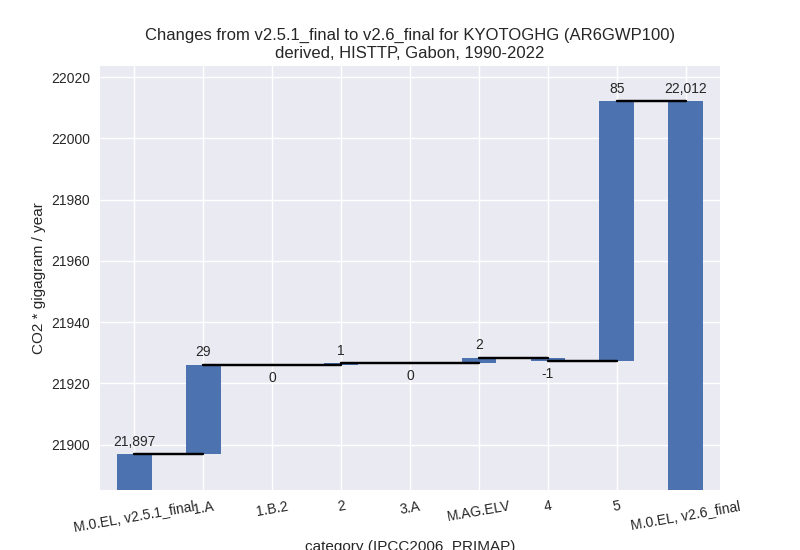
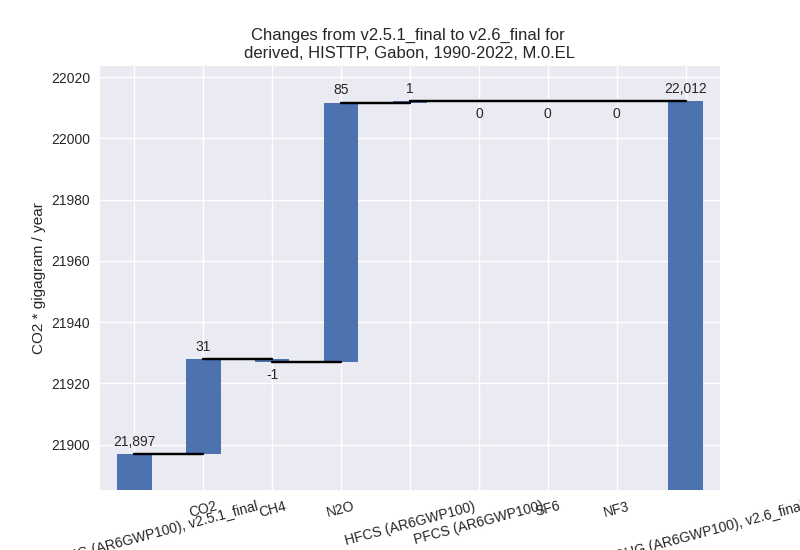
Detailed changes for the scenarios:
country reported scenario (HISTCR):
Most important changes per time frame
For 2022 the following sector-gas combinations have the highest absolute impact on national total KyotoGHG (AR6GWP100) emissions in 2022 (top 5):
- 1: 1.A, CO2 with 784.72 Gg CO2 / year (27.3%)
- 2: 2, HFCS (AR6GWP100) with 17.16 Gg CO2 / year (8.5%)
- 3: 5, N2O with -16.70 Gg CO2 / year (-11.5%)
- 4: M.AG.ELV, CO2 with 3.28 Gg CO2 / year (247.5%)
- 5: 4, CO2 with -0.03 Gg CO2 / year (-1.2%)
For 1990-2022 the following sector-gas combinations have the highest absolute impact on national total KyotoGHG (AR6GWP100) emissions in 1990-2022 (top 5):
- 1: 5, N2O with 84.98 Gg CO2 / year (107.3%)
- 2: 1.A, CO2 with 30.01 Gg CO2 / year (1.5%)
- 3: M.AG.ELV, CO2 with 1.74 Gg CO2 / year (182.7%)
- 4: 2, HFCS (AR6GWP100) with 0.52 Gg CO2 / year (0.8%)
- 5: 4, CO2 with -0.00 Gg CO2 / year (-0.3%)
Changes in the main sectors for aggregate KyotoGHG (AR6GWP100) are
- 1: Total sectoral emissions in 2022 are 5591.77 Gg
CO2 / year which is 83.7% of M.0.EL emissions. 2022 Emissions have
changed by 16.3% (784.72 Gg CO2 /
year). 1990-2022 Emissions have changed by 0.7% (30.01 Gg CO2 / year). For 2022 the
changes per gas
are:
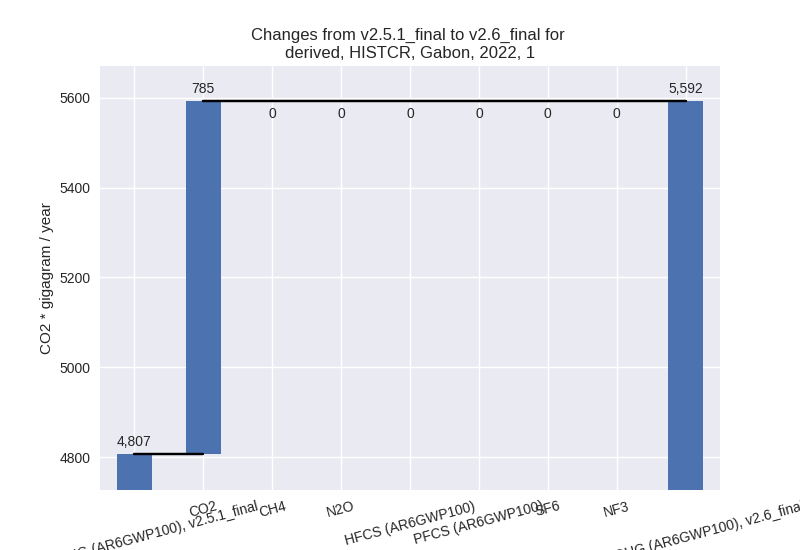
The changes come from the following subsectors:- 1.A: Total sectoral emissions in 2022 are 3685.83
Gg CO2 / year which is 65.9% of category 1 emissions. 2022 Emissions
have changed by 27.0% (784.72 Gg CO2
/ year). 1990-2022 Emissions have changed by 1.5% (30.01 Gg CO2 / year). For 2022 the
changes per gas
are:
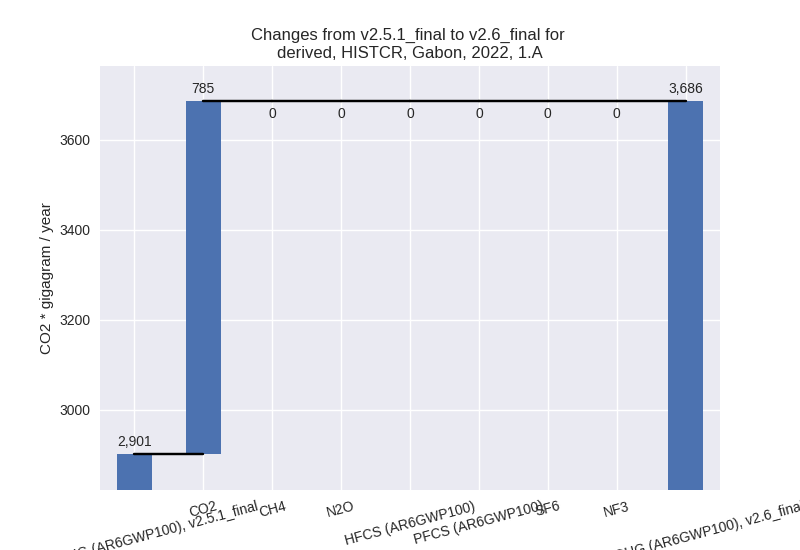
There is no subsector information available in PRIMAP-hist. - 1.B.2: Total sectoral emissions in 2022 are 1905.94 Gg CO2 / year which is 34.1% of category 1 emissions. 2022 Emissions have changed by 0.0% (0.00 Gg CO2 / year). 1990-2022 Emissions have changed by 0.0% (0.00 Gg CO2 / year).
- 1.A: Total sectoral emissions in 2022 are 3685.83
Gg CO2 / year which is 65.9% of category 1 emissions. 2022 Emissions
have changed by 27.0% (784.72 Gg CO2
/ year). 1990-2022 Emissions have changed by 1.5% (30.01 Gg CO2 / year). For 2022 the
changes per gas
are:
- 2: Total sectoral emissions in 2022 are 317.46 Gg
CO2 / year which is 4.8% of M.0.EL emissions. 2022 Emissions have
changed by 5.7% (17.16 Gg CO2 /
year). 1990-2022 Emissions have changed by 0.3% (0.52 Gg CO2 / year). For 2022 the
changes per gas
are:
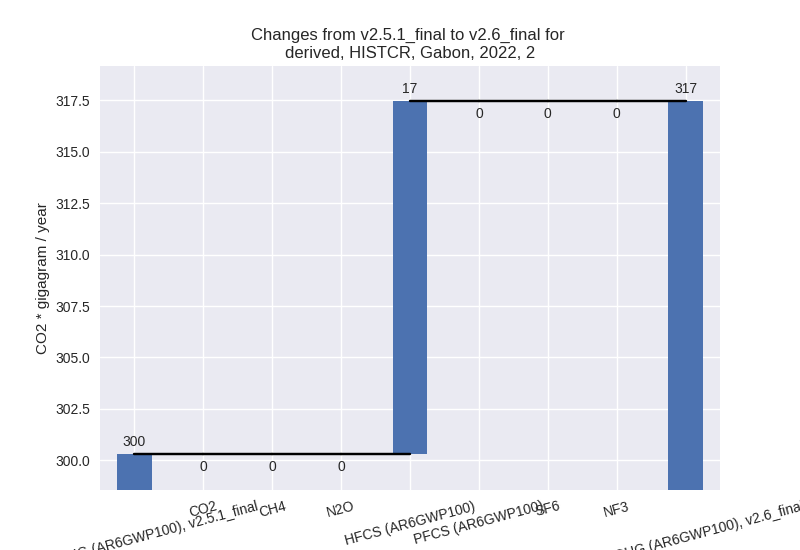
- M.AG: Total sectoral emissions in 2022 are 639.97 Gg CO2 / year which is 9.6% of M.0.EL emissions. 2022 Emissions have changed by 0.5% (3.28 Gg CO2 / year). 1990-2022 Emissions have changed by 0.2% (1.74 Gg CO2 / year).
- 4: Total sectoral emissions in 2022 are 4.03 Gg CO2 / year which is 0.1% of M.0.EL emissions. 2022 Emissions have changed by -1.3% (-0.05 Gg CO2 / year). 1990-2022 Emissions have changed by -0.2% (-0.00 Gg CO2 / year).
- 5: Total sectoral emissions in 2022 are 129.03 Gg
CO2 / year which is 1.9% of M.0.EL emissions. 2022 Emissions have
changed by -11.5% (-16.70 Gg CO2 /
year). 1990-2022 Emissions have changed by 107.3% (84.98 Gg CO2 / year). For 2022 the
changes per gas
are:
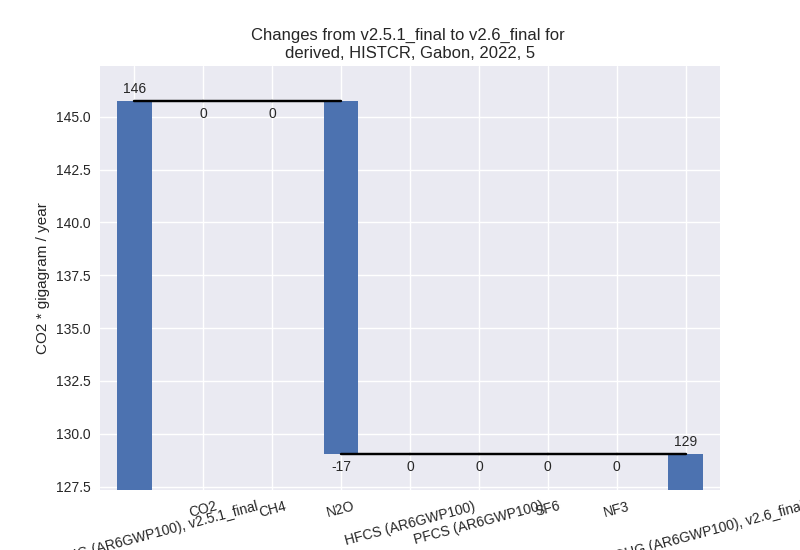
For 1990-2022 the changes per gas are: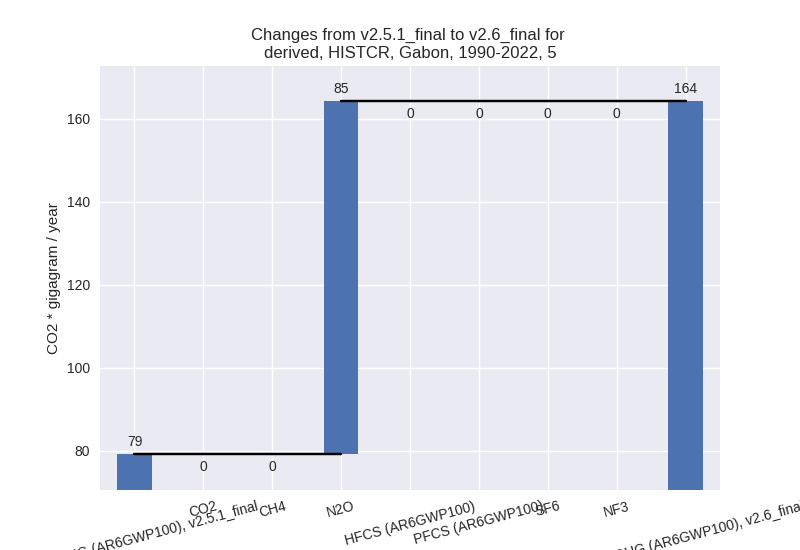
third party scenario (HISTTP):
Most important changes per time frame
For 2022 the following sector-gas combinations have the highest absolute impact on national total KyotoGHG (AR6GWP100) emissions in 2022 (top 5):
- 1: 1.A, CO2 with 764.76 Gg CO2 / year (27.3%)
- 2: 2, HFCS (AR6GWP100) with 17.98 Gg CO2 / year (1.5%)
- 3: 5, N2O with -16.70 Gg CO2 / year (-11.5%)
- 4: 4, CH4 with -8.15 Gg CO2 / year (-1.6%)
- 5: M.AG.ELV, CO2 with 3.28 Gg CO2 / year (247.5%)
For 1990-2022 the following sector-gas combinations have the highest absolute impact on national total KyotoGHG (AR6GWP100) emissions in 1990-2022 (top 5):
- 1: 5, N2O with 84.98 Gg CO2 / year (107.3%)
- 2: 1.A, CO2 with 29.24 Gg CO2 / year (1.4%)
- 3: M.AG.ELV, CO2 with 1.74 Gg CO2 / year (182.7%)
- 4: 4, CH4 with -0.99 Gg CO2 / year (-0.3%)
- 5: 2, HFCS (AR6GWP100) with 0.54 Gg CO2 / year (0.1%)
Changes in the main sectors for aggregate KyotoGHG (AR6GWP100) are
- 1: Total sectoral emissions in 2022 are 16777.29 Gg
CO2 / year which is 86.8% of M.0.EL emissions. 2022 Emissions have
changed by 4.8% (764.76 Gg CO2 /
year). 1990-2022 Emissions have changed by 0.1% (29.24 Gg CO2 / year). For 2022 the
changes per gas
are:
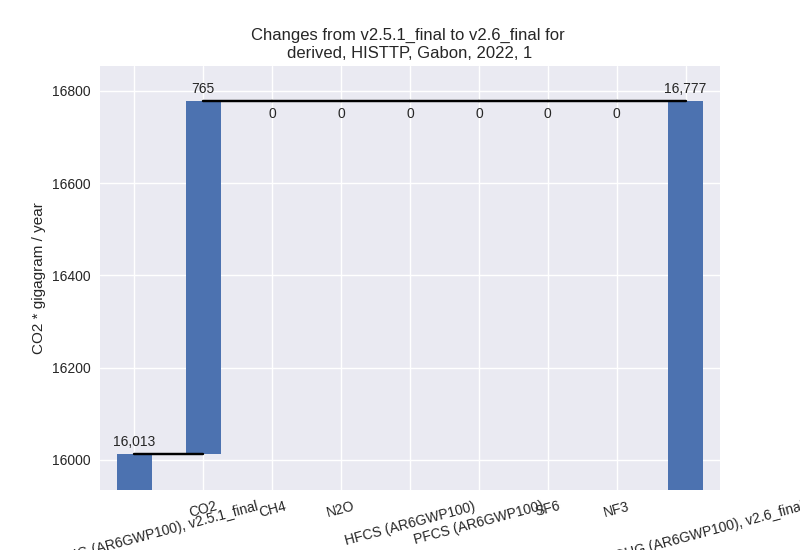
The changes come from the following subsectors:- 1.A: Total sectoral emissions in 2022 are 4220.99
Gg CO2 / year which is 25.2% of category 1 emissions. 2022 Emissions
have changed by 22.1% (764.76 Gg CO2
/ year). 1990-2022 Emissions have changed by 1.2% (29.24 Gg CO2 / year). For 2022 the
changes per gas
are:
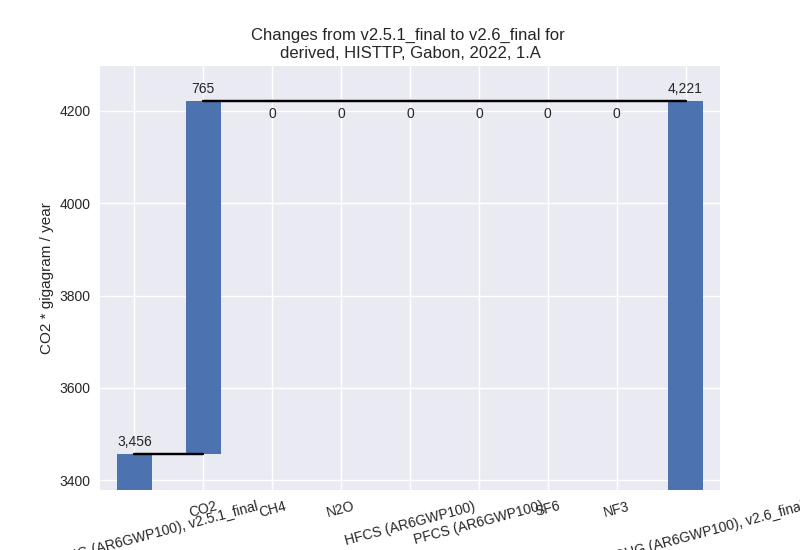
There is no subsector information available in PRIMAP-hist. - 1.B.2: Total sectoral emissions in 2022 are 12556.30 Gg CO2 / year which is 74.8% of category 1 emissions. 2022 Emissions have changed by 0.0% (0.00 Gg CO2 / year). 1990-2022 Emissions have changed by 0.0% (0.00 Gg CO2 / year).
- 1.A: Total sectoral emissions in 2022 are 4220.99
Gg CO2 / year which is 25.2% of category 1 emissions. 2022 Emissions
have changed by 22.1% (764.76 Gg CO2
/ year). 1990-2022 Emissions have changed by 1.2% (29.24 Gg CO2 / year). For 2022 the
changes per gas
are:
- 2: Total sectoral emissions in 2022 are 1458.45 Gg CO2 / year which is 7.5% of M.0.EL emissions. 2022 Emissions have changed by 1.2% (17.98 Gg CO2 / year). 1990-2022 Emissions have changed by 0.1% (0.54 Gg CO2 / year).
- M.AG: Total sectoral emissions in 2022 are 442.21 Gg CO2 / year which is 2.3% of M.0.EL emissions. 2022 Emissions have changed by 0.7% (3.28 Gg CO2 / year). 1990-2022 Emissions have changed by 0.4% (1.74 Gg CO2 / year).
- 4: Total sectoral emissions in 2022 are 530.05 Gg CO2 / year which is 2.7% of M.0.EL emissions. 2022 Emissions have changed by -1.8% (-9.95 Gg CO2 / year). 1990-2022 Emissions have changed by -0.3% (-1.21 Gg CO2 / year).
- 5: Total sectoral emissions in 2022 are 129.03 Gg
CO2 / year which is 0.7% of M.0.EL emissions. 2022 Emissions have
changed by -11.5% (-16.70 Gg CO2 /
year). 1990-2022 Emissions have changed by 107.3% (84.98 Gg CO2 / year). For 2022 the
changes per gas
are:
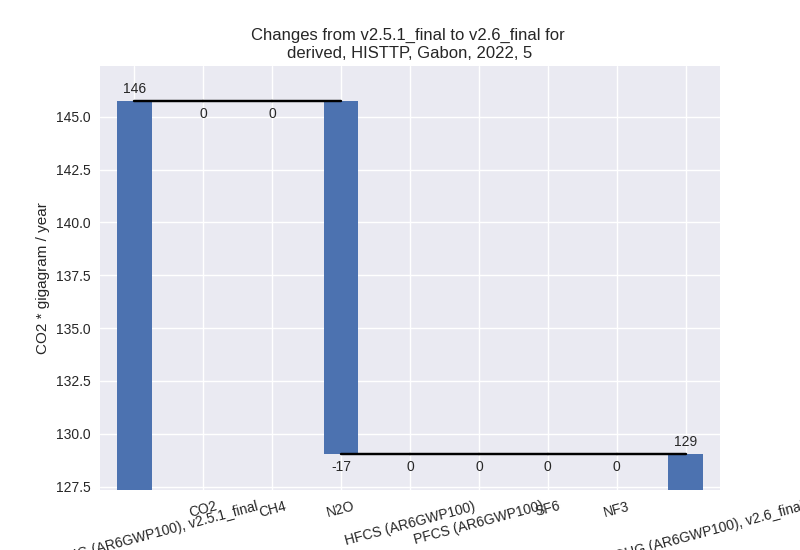
For 1990-2022 the changes per gas are: